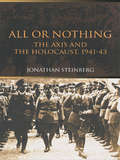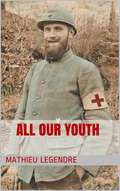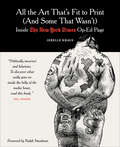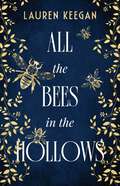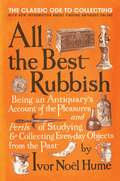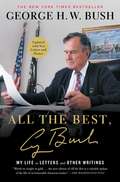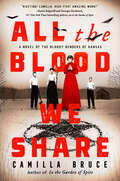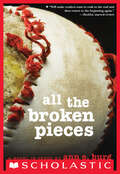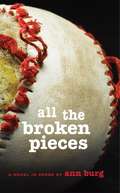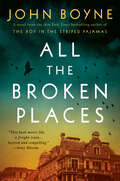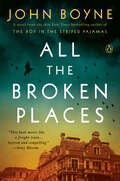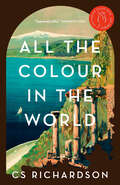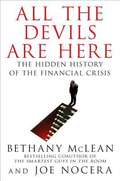- Table View
- List View
All or Nothing: How Trump Recaptured America
by Michael Wolff"He is FAKE NEWS, a total LOSER, and no one should waste their time or money in buying this boring and obviously fictitious book!" Donald Trump, President of the United States"Gripping-a veritable harvest of slime, sycophancy and sleaze that tells the story of Trump 2.0, an aggrieved pugilist waging a 'life or death' campaign." New York Times"Michael Wolff... the shrewdest and most colourful chronicler of the Trump years," Sunday TimesAll or Nothing is the final chapter in Wolff's Fire and Fury series. With extraordinary behind-the-scenes access, it follows every turn of Donald Trump's third presidential campaign. In disgrace after the January 6 attack on the Capitol and sent into exile, Trump immediately sputters back to life. To the shock of the Republican Party leadership, the Trump base has not abandoned him. Hardly a year on, he is as strong as any challenger has ever been. The American establishment is stunned by his comeback and determined to stop it and hold him accountable for his abuses of law and power. Equally, he has vowed retribution on anyone who tries to stand in his way. The 2024 presidential race is elemental: the system breaks Donald Trump or Donald Trump breaks the system.Michael Wolff tells this story from inside the Trump campaign. Through the sources he has cultivated over his ten years of writing about Donald Trump, including people who are with Trump on a daily basis, as well as his own first-hand reporting, we get a nearly moment-by-moment picture of the pendulum mood swings, the casual cruelties, the demands for obeisance, the preternatural resolve or otherworldly levels of denial, and the certain flashes of showman genius of the new president.Praise for Fire and Fury, Siege and Landslide"A book to shake America to its foundations" TheGuardian"Cruel, unforgiving, muckracking, scandalous. I couldn't stop reading it." The Telegraph"Hilarious and frightening, and often reads like a Hollywood gossip column" Financial Times"Smart, vivid and intrepid," The New York Times
All or Nothing: How Trump Recaptured America
by Michael Wolff"He is FAKE NEWS, a total LOSER, and no one should waste their time or money in buying this boring and obviously fictitious book!" Donald Trump, President of the United States"Gripping-a veritable harvest of slime, sycophancy and sleaze that tells the story of Trump 2.0, an aggrieved pugilist waging a 'life or death' campaign." New York Times"Michael Wolff... the shrewdest and most colourful chronicler of the Trump years," Sunday TimesAll or Nothing is the final chapter in Wolff's Fire and Fury series. With extraordinary behind-the-scenes access, it follows every turn of Donald Trump's third presidential campaign. In disgrace after the January 6 attack on the Capitol and sent into exile, Trump immediately sputters back to life. To the shock of the Republican Party leadership, the Trump base has not abandoned him. Hardly a year on, he is as strong as any challenger has ever been. The American establishment is stunned by his comeback and determined to stop it and hold him accountable for his abuses of law and power. Equally, he has vowed retribution on anyone who tries to stand in his way. The 2024 presidential race is elemental: the system breaks Donald Trump or Donald Trump breaks the system.Michael Wolff tells this story from inside the Trump campaign. Through the sources he has cultivated over his ten years of writing about Donald Trump, including people who are with Trump on a daily basis, as well as his own first-hand reporting, we get a nearly moment-by-moment picture of the pendulum mood swings, the casual cruelties, the demands for obeisance, the preternatural resolve or otherworldly levels of denial, and the certain flashes of showman genius of the new president.Praise for Fire and Fury, Siege and Landslide"A book to shake America to its foundations" TheGuardian"Cruel, unforgiving, muckracking, scandalous. I couldn't stop reading it." The Telegraph"Hilarious and frightening, and often reads like a Hollywood gossip column" Financial Times"Smart, vivid and intrepid," The New York Times
All or Nothing: The Axis and the Holocaust 1941-43
by Jonathan SteinbergGerman and Italian fascist armies in the Second World War treated the Jews quite differently. Jews who fell into the hands of the German army ended up in concentration camps; none of those taken by the Italians suffered the same fate. Yet the protectors of the Jews were no philo-Semites, nor were they (often) great respecters of human life. Some of those same officers had sanctioned savage atrocities against Ethiopians and Arabs in the years before the war. Jonathan Steinberg uses this remarkable and poignant story to unravel the motives and forces underpinning both Fascism and Nazism. As a renowned historian of both Germany and Italy, he is uniquely placed to answer the underlying question; why?
All our youth
by Mathieu LegendreThe epic story of stretcher bearer Tabouret. Follow Camille Tabouret from 1914 to 1919 and discover the main theatres of operation on the French front. Mathieu Legendre has adapted the war diary of Camille Tabouret to create a modern and dynamic narrative that provides readers with a unique perspective of the war to end all wars. Accompany Camille on his duty to recover the wounded and dead right up to enemy lines, in the hell of the trenches, and on the exhausting movements of his regiment. Having survived the First World War, Camille left behind an incredible account of his experiences, now available for all to read.
All that Hollywood Allows: Re-reading Gender in 1950s Melodrama (Gender And American Culture Ser.)
by Jackie ByarsAll that Hollywood Allows explores the representation of gender in popular Hollywood melodramas of the 1950s. Both a work of feminist film criticism and theory and an analysis of popular culture, this provocative book examines from a cultural studies perspective top-grossing film melodramas, such as A Streetcar Named Desire, From Here to Eternity, East of Eden, Imitation of Life and Picnic. Stereotypically viewed as a complacent and idyllic time, the 1950s were actually a time of dislocation and great social change. Jackie Byars argues that mass media texts of the period, especially films, provide evidence of society's consuming preoccupation with the domestic sphere - the nuclear family and its values - and she shows how Hollywood melodramas interpreted and extended societal debates concerning family structure, sexual divisions of labour, and gender roles. Her readings of these films assess a variety of critical methodologies and approaches to textual analysis, some central to feminist film studies and some previously bypassed by scholars in the field.
All the Art That's Fit to Print (And Some That Wasn't): Inside The New York Times Op-Ed Page
by Jerelle KrausAll the Art That's Fit to Print reveals the true story of the world's first Op-Ed page, a public platform that—in 1970—prefigured the Internet blogosphere. Not only did the New York Times's nonstaff bylines shatter tradition, but the pictures were revolutionary. Unlike anything ever seen in a newspaper, Op-Ed art became a globally influential idiom that reached beyond narrative for metaphor and changed illustration's very purpose and potential. Jerelle Kraus, whose thirteen-year tenure as Op-Ed art director far exceeds that of any other art director or editor, unveils a riveting account of working at the Times. <P><P>Her insider anecdotes include the reasons why artist Saul Steinberg hated the Times, why editor Howell Raines stopped the presses to kill a feature by Doonesbury's Garry Trudeau, and why reporter Syd Schanburg-whose story was told in the movie The Killing Fields-stated that he would travel anywhere to see Kissinger hanged, as well as Kraus's tale of surviving two and a half hours alone with the dethroned peerless outlaw, Richard Nixon.All the Art features a satiric portrayal of John McCain, a classic cartoon of Barack Obama by Jules Feiffer, and a drawing of Hillary Clinton and Obama by Barry Blitt. But when Frank Rich wrote a column discussing Hillary Clinton exclusively, the Times refused to allow Blitt to portray her. Nearly any notion is palatable in prose, yet editors perceive pictures as a far greater threat. Confucius underestimated the number of words an image is worth; the thousand-fold power of a picture is also its curse.Op-Ed's subject is the world, and its illustrations are created by the world's finest graphic artists. The 142 artists whose work appears in this book hail from thirty nations and five continents, and their 324 pictures-gleaned from a total of 30,000-reflect artists' common drive to communicate their creative visions and to stir our vibrant cultural-political pot.
All the Beautiful Girls: A Novel
by Elizabeth J. ChurchNo one captures the exuberant passions and inner struggles of women like Elizabeth Church.”—Martha Hall Kelly, author of Lilac GirlsA powerful novel about a gutsy showgirl who tries to conquer her past amongst the glamour of 1960s Las Vegas—and finds unexpected fortune, friendship, and love. It was unimaginable. When she was eight years old, Lily Decker somehow survived the auto accident that killed her parents and sister, but neither her emotionally distant aunt nor her all-too-attentive uncle could ease her grief. Dancing proves to be Lily’s only solace, and eventually she receives a “scholarship” to a local dance academy—courtesy of a mysterious benefactor. Grown and ready to leave home for good, Lily changes her name to Ruby Wilde and heads to Las Vegas to be a troupe dancer, but her sensual beauty and voluptuous figure land her work instead as a showgirl performing everywhere from Les Folies Bergere at the Tropicana to the Stardust’s Lido de Paris. Wearing sky-high headdresses, five-inch heels, and costumes dripping with feathers and rhinestones, Ruby may have all the looks of a Sin City success story, but she still must learn to navigate the world of men—and figure out what real love looks like. With her uncanny knack for understanding the hidden lives of women, Elizabeth J. Church captures both the iconic extravagance of an era and the bravery of a young woman who dances through her sadness to find connection, freedom, and, most important, herself. Advance praise for All the Beautiful Girls“A gorgeously written novel with the bite of a gin martini, All the Beautiful Girls goes beyond the splashy, gaudy dazzle of Las Vegas in the sixties to reveal the beating heart beneath the glamorous façade of a showgirl with big ambitions.”—Sara Gruen, New York Times bestselling author of At the Water’s Edge“A razzle-dazzle novel about loss, love, and friendship . . . All the Beautiful Girls pulls back the curtain on the glamorous, titillating world of showgirls, revealing the emotional bruises hidden beneath the dazzling costumes.”—Melanie Benjamin, New York Times bestselling author of The Swans of Fifth Avenue“A beautifully rendered tale of personal redemption filled with friendship, loss, extravagant furs, and feathery headdresses.”—Kirkus Reviews
All the Beauty of the Sun
by Marion HusbandSoho 1925 Two young men meet - for one of them this is love at first sight, for the other only lust and guilt... In 1925 Paul Harris returns to England from self-imposed exile in Tangiers for an exhibition of his paintings. He leaves behind Patrick, the man he has loved since they met in the trenches in 1918, needing to discover if he has the strength to live without him and wanting to explore the kind of life he might have lived had it not been for the war. In Bohemian Soho, Paul meets Edmund whose passionate love changes Paul's idea of himself. With Edmund, Paul begins to believe that he may have another life to live, free of the guilt and regrets of the past. But the past is not so easy to escape, and when Patrick follows Paul to London a decision must be made that will affect all their lives.
All the Beauty of the Sun: The Boy I Love: Book Two (The Boy I Love #2)
by Marion HusbandTwo young men meet in Soho - for one of them this is love at first sight, for the other only lust and guilt . . .'Marion Husband explores the morality of wartime Britain with intelligent and compassionate insight' MslexiaIn 1925, Paul Harris returns to England from self-imposed exile in Tangiers in order to put on an exhibition of his paintings. In this move he is leaving behind Patrick, the man he has loved since they met in the trenches in 1918, needing to discover if he has the strength to live without him and wanting to explore the kind of life he might have lived had it not been for the war. In Bohemian Soho, Paul meets Edmund. Paul begins to believe that he may have another life to live, free of the guilt and regrets of the past. But the past is not so easy to escape, and when Patrick follows Paul to London a decision must be made that will change everything.Just some of the amazing GOODREADS REVIEWS:'Another fantastic book by Marion Husband.''I just love the way Marion Husband writes. There is not a single rock left unturned.''Don't miss this series - if you love the power of words, words rich in layer and tone . . . you will love them. Can't recommend them enough.'
All the Beauty of the Sun: The Boy I Love: Book Two (The\boy I Love Trilogy Ser. #2)
by Marion HusbandTwo young men meet in Soho - for one of them this is love at first sight, for the other only lust and guilt . . .'Marion Husband explores the morality of wartime Britain with intelligent and compassionate insight' MslexiaIn 1925, Paul Harris returns to England from self-imposed exile in Tangiers in order to put on an exhibition of his paintings. In this move he is leaving behind Patrick, the man he has loved since they met in the trenches in 1918, needing to discover if he has the strength to live without him and wanting to explore the kind of life he might have lived had it not been for the war. In Bohemian Soho, Paul meets Edmund. Paul begins to believe that he may have another life to live, free of the guilt and regrets of the past. But the past is not so easy to escape, and when Patrick follows Paul to London a decision must be made that will change everything.Just some of the amazing GOODREADS REVIEWS:'Another fantastic book by Marion Husband.''I just love the way Marion Husband writes. There is not a single rock left unturned.''Don't miss this series - if you love the power of words, words rich in layer and tone . . . you will love them. Can't recommend them enough.'
All the Bees in the Hallows
by Lauren KeeganBees choose their masters. Bees don't sting good people.Marytè is a devoted beekeeper. She lives by the old rules: work with fellow beekeepers, be a good Christian and a good harvest will follow. These rules help her cope with her grief when she inherits her husband's tree hollows. But as harsh conditions and tax increases threaten the harvest, Marytè begins to question her faith, her community and her own sanity.There is little help to be had from her eldest daughter. Austėja is no worker bee. She takes risks, speaks her mind and dreams of escaping their isolated community. As her mother works, she finds refuge in the ancient forest and the old beliefs instilled in her by her defiant grandmother.When Austėja discovers the mutilated body of the Hollow Watcher and uncovers a honeycomb of lies and betrayal, she is intent on finding the truth and protecting her family. Will mother and daughter overcome their differences, learn the truth behind the murder and complete the honey harvest?
All the Bees in the Hallows
by Lauren KeeganBees choose their masters. Bees don't sting good people.Marytè is a devoted beekeeper. She lives by the old rules: work with fellow beekeepers, be a good Christian and a good harvest will follow. These rules help her cope with her grief when she inherits her husband's tree hollows. But as harsh conditions and tax increases threaten the harvest, Marytè begins to question her faith, her community and her own sanity.There is little help to be had from her eldest daughter. Austėja is no worker bee. She takes risks, speaks her mind and dreams of escaping their isolated community. As her mother works, she finds refuge in the ancient forest and the old beliefs instilled in her by her defiant grandmother.When Austėja discovers the mutilated body of the Hollow Watcher and uncovers a honeycomb of lies and betrayal, she is intent on finding the truth and protecting her family. Will mother and daughter overcome their differences, learn the truth behind the murder and complete the honey harvest?
All the Best Rubbish
by Ivor Noël HumeOne person's trash is another's treasure! In his newly revised classic, All the Best Rubbish, Ivor NoËl Hume traces the fascinating history of collecting from its recorded beginnings and describes the remarkable detective work that goes into establishing the probable facts about uncovered and often underappreciated treasures. Now expanded with hints, tips, and helpful information about antique-hunting online, All the Best Rubbish is the ideal book for the antiquarian or amateur, the historian or professional collector--for anyone who knows that there's no such thing as "just junk."
All the Best, George Bush: My Life in Letters and Other Writings
by George H.W. BushFormer President George H.W. Bush, revealed through his letters and writings from 1941 to 2010, is "worth its weight in gold...a valuable update of the life of an honorable American leader" (The Washington Post)."Who knew that beneath George Bush's buttoned-up propriety pulsed the warm heart of a prolific and occasionally poetic writer with a wacky sense of humor?" (People) Though reticent in public, George Bush openly shared his private thoughts in correspondence throughout his life. This collection of letters, diary entries, and memos is the closest we'll ever get to his autobiography.Organized chronologically, readers will gain insights into Bush's career highlights--the oil business, his two terms in Congress, his ambassadorship to the UN, his service as an envoy to China, his tenure with the Central Intelligence Agency, and of course, the vice presidency, the presidency, and the post-presidency. They will also observe a devoted husband, father, and American. Ranging from a love letter to Barbara and a letter to his mother about missing his daughter, Robin, after her death from leukemia to a letter to his children written just before the beginning of Desert Storm, this collection is remarkable for Bush's candor, humor, and poignancy. "An unusual glimpse of the private thoughts of a public figure" (Newsweek), this revised edition includes new letters and photographs that highlight the Bush family's enduring legacy, including letters that cover George W. Bush's presidency, 9/11, Bush senior's work with President Clinton to help the victims of natural disasters, and the meaning of friendship and family. All the Best, George Bush "will shed more light on the man's personal character and public persona than any memoir or biography could" (Publishers Weekly).
All the Blood We Share: A Novel of the Bloody Benders of Kansas
by Camilla BruceA sinister novel based on the real Bloody Benders, a family of serial killers in the old West bound by butchery and obscured by the shadows of American history.The winds shift nervously on the Kansas plain whispering of travelers lost and buried, whispering of witches. Something dark and twisted has taken root at the Bender Inn. At first the townspeople of Cherryvale welcome the rising medium Kate Bender and her family. Kate's messages from the Beyond give their tedious dreams hope and her mother's potions cure their little ills—for a price. No one knows about their other business, the shortcut to a better life. And why shouldn&’t their family prosper? They&’re careful. It&’s only from those who are marked, those who travel alone and can easily disappear, that the Benders demand their pound of flesh. But even a gifted seer like Kate can make a misstep. Now as the secrets festering beneath the soil of the family orchard threaten to bring them all to ruin, the Benders must sharpen their craft—or vanish themselves.
All the Broken Pieces
by Ann E. BurgAn award-winning debut novel from a stellar new voice in middle grade fiction. Matt Pin would like to forget: war torn Vietnam, bombs that fell like dead crows, and the terrible secret he left behind. But now that he is living with a caring adoptive family in the United States, he finds himself forced to confront his past. And that means choosing between silence and candor, blame and forgiveness, fear and freedom. By turns harrowing, dreamlike, sad, and triumphant, this searing debut novel, written in lucid verse, reveals an unforgettable perspective on the lasting impact of war and the healing power of love.
All the Broken Pieces: A Novel in Verse
by Ann E. BurgTwo years after being airlifted out of Vietnam in 1975, Matt Pin is haunted by the terrible secret he left behind, and now, in a loving adoptive home in the United States, a series of profound events forces him to confront his past.
All the Broken Places: A Novel
by John BoyneFrom the New York Times bestselling author John Boyne, a devastating, beautiful story about a woman who must confront the sins of her own terrible past, and a present in which it is never too late for bravery.Ninety-one-year-old Gretel Fernsby has lived in the same well-to-do mansion block in London for decades. She lives a quiet, comfortable life, despite her deeply disturbing, dark past. She doesn't talk about her escape from Nazi Germany at age twelve. She doesn't talk about the grim post-war years in France with her mother. Most of all, she doesn't talk about her father, who was the commandant of one of the Reich's most notorious extermination camps. Then, a new family moves into the apartment below her. In spite of herself, Gretel can't help but begin a friendship with the little boy, Henry, though his presence brings back memories she would rather forget. One night, she witnesses a disturbing, violent argument between Henry's beautiful mother and his arrogant father, one that threatens Gretel's hard-won, self-contained existence. All The Broken Places moves back and forth in time between Gretel's girlhood in Germany to present-day London as a woman whose life has been haunted by the past. Now, Gretel faces a similar crossroads to one she encountered long ago. Back then, she denied her own complicity, but now, faced with a chance to interrogate her guilt, grief and remorse, she can choose to save a young boy. If she does, she will be forced to reveal the secrets she has spent a lifetime protecting. This time, she can make a different choice than before--whatever the cost to herself . . .
All the Broken Places: A Novel
by John Boyne&“You can&’t prepare yourself for the magnitude and emotional impact of this powerful novel.&” —John Irving, #1 New York Times bestselling author of The World According to Garp &“Exceptional, layered and compelling…This book moves like a freight train.&” —Amy Bloom, New York Times bestselling author of In LoveFrom the New York Times bestselling author John Boyne, a devastating, beautiful story about a woman who must confront the sins of her own terrible past, and a present in which it is never too late for braveryNinety-one-year-old Gretel Fernsby has lived in the same well-to-do mansion block in London for decades. She lives a quiet, comfortable life, despite her deeply disturbing, dark past. She doesn&’t talk about her escape from Nazi Germany at age 12. She doesn&’t talk about the grim post-war years in France with her mother. Most of all, she doesn&’t talk about her father, who was the commandant of one of the Reich&’s most notorious extermination camps. Then, a new family moves into the apartment below her. In spite of herself, Gretel can&’t help but begin a friendship with the little boy, Henry, though his presence brings back memories she would rather forget. One night, she witnesses a disturbing, violent argument between Henry&’s beautiful mother and his arrogant father, one that threatens Gretel&’s hard-won, self-contained existence.All The Broken Places moves back and forth in time between Gretel&’s girlhood in Germany to present-day London as a woman whose life has been haunted by the past. Now, Gretel faces a similar crossroads to one she encountered long ago. Back then, she denied her own complicity, but now, faced with a chance to interrogate her guilt, grief and remorse, she can choose to save a young boy. If she does, she will be forced to reveal the secrets she has spent a lifetime protecting. This time, she can make a different choice than before—whatever the cost to herself….
All the Broken Soldiers: Private Kennedy's War
by Dr Jan McLeod Dr Andrew McLeodThis is the story of a soldier without a gun. It is personal, yet universal. It is the story of what is left behind when the battles have been fought and the war has moved on.To the Australian Army, Private Lawrence Nicholas Kennedy was NX21854, a soldier who served for 1907 days with the 2/4th Australian Army Field Ambulance in Australia, the Middle East, the Kokoda Track and New Guinea during World War II. With older brother, Bill by his side, the Kennedy boys experienced the adventure and the joy, the loss and the despair of war – like too many others before and since. To those who knew Nick Kennedy after the war, he was a dedicated and professional psychiatric nurse. To the author, he was her gentle Uncle Nick, remembered as a kind, funny and generous man who seemed older than his years. The small diary he kept during World War II helped her understand why that was so. Kennedy&’s words and photographs tell the harrowing and compelling story of one young man who went to war – not to kill the enemy, but to save his fellow soldiers – only to return home forever changed by the challenges, hardships and tragedy he experienced. All the Broken Soldiers provides a rare insight into an aspect of war fought by soldiers equipped with little more than a basic medical kit and a Red Cross armband … those who cared for the broken soldiers that war leaves behind.
All the Colour in the World: A Novel
by CS RichardsonThe story of the restorative power of art in one man&’s life, set against the sweep of the twentieth century—from Toronto in the &’20s and &’30s, through the killing fields of World War II, to 1960s Sicily.&“Bold and resplendent. . . . Leave it to CS Richardson to find a way to paint with words.&” —Nita Prose, #1 New York Times bestselling author of The MaidHenry, born 1916, thin-as-sticks, nearsighted, is an obsessive doodler—copying illustrations from his Boy&’s Own magazines. Left in the care of a nurturing, Shakespeare-quoting grandmother, eight-year-old Henry receives as a gift his first set of colouring pencils (and a pocket knife for the sharpening). As he commits these colours to memory—cadmium yellow; burnt ochre; deep scarlet red—a passion for art, colour, and the stories of the great artists takes hold, and becomes Henry&’s unique way of seeing the world. It is a passion that will both haunt and sustain him on his journey through the century: from boyhood dreams on a summer beach to the hothouse of art academia and a love cut short by tragedy; from the psychological wounds of war to the redemption of unexpected love.Projected against a backdrop of iconic masterpieces—from the rich hues of the European masters to the technicolour magic of Hollywood—All the Colour in the World is Henry&’s story: part miscellany, part memory palace, exquisitely precise with the emotional sweep of a great modern romance.
All the Dead Shall Weep (Gunnie Rose #5)
by Charlaine Harris#1 New York Times and USA TODAY bestselling author Charlaine Harris returns with the fifth installment in the bestselling Gunnie Rose series as sisters Lizbeth Rose and Felicia as well as brothers Eli and Peter, are reunited in Texoma only to break apart before the Wizard&’s Ball held in San Diego, which will determine all their fates.Following the murderous events of the &“gripping…thrill-ride&” (Karin Slaughter) Serpent of Heaven, Lizbeth Rose is awaiting the arrival of her sister Felicia and her husband&’s younger brother Eli in Texoma. Both needed to leave the seat of the Holy Russian Empire in San Diego after Felicia&’s burgeoning wizardly power in death magic became the reason for kidnapping and assassination attempts from her mother&’s family of high-powered wizards in Mexico. Yet bad news has traveled ahead of them, as Eli is called back to San Diego, taking Peter along with him, splitting them apart in more ways than one as their enemies&’ plans for revenge come to fruition. In this fifth installment in the beloved and bestselling Gunnie Rose series, #1 New York Times and USA TODAY bestselling author Charlaine Harris has crafted a family drama of murderous and magical thrills.
All the Dear Faces
by Audrey HowardMara O'Shaughnessy, eighth of thirteen children, longs to escape from the crowded tumult of her family. Her sister Caitlin, quiet but determined, is already involved with the suffragettes. Meanwhile, Elizabeth Woodall lives at Woodall Park with her parents in a world of servanted ease, country pursuits and suitable marriages. Yet in the golden years before World War I, Liverpool Irish and English gentry are to become fatefully, passionately entangled.
All the Devils Are Here: The Hidden History of the Financial Crisis
by Bethany Mclean Joe NoceraAs soon as the financial crisis erupted, the finger-pointing began. Should the blame fall on Wall Street, Main Street, or Pennsylvania Avenue? On greedy traders, misguided regulators, sleazy subprime companies, cowardly legislators, or clueless home buyers?<P><P> According to Bethany McLean and Joe Nocera, two of America's most acclaimed business journalists, the real answer is all of the above-and more. Many devils helped bring hell to the economy. And the full story, in all of its complexity and detail, is like the legend of the blind men and the elephant. Almost everyone has missed the big picture. Almost no one has put all the pieces together.<P> All the Devils Are Here goes back several decades to weave the hidden history of the financial crisis in a way no previous book has done. It explores the motivations of everyone from famous CEOs, cabinet secretaries, and politicians to anonymous lenders, borrowers, analysts, and Wall Street traders. It delves into the powerful American mythology of homeownership. And it proves that the crisis ultimately wasn't about finance at all; it was about human nature.<P> Among the devils you'll meet in vivid detail:<P> * Angelo Mozilo, the CEO of Countrywide, who dreamed of spreading homeownership to the masses, only to succumb to the peer pressure-and the outsized profits-of the sleaziest subprime lending.<P> * Roland Arnall, a respected philanthropist and diplomat, who made his fortune building Ameriquest, a subprime lending empire that relied on blatantly deceptive lending practices.<P> * Hank Greenberg, who built AIG into a Rube Goldberg contraption with an undeserved triple-A rating, and who ran it so tightly that he was the only one who knew where all the bodies were buried.<P> * Stan O'Neal of Merrill Lynch, aloof and suspicious, who suffered from "Goldman envy" and drove a proud old firm into the ground by promoting cronies and pushing out his smartest lieutenants.<P> * Lloyd Blankfein, who helped turn Goldman Sachs from a culture that famously put clients first to one that made clients secondary to its own bottom line.<P> * Franklin Raines of Fannie Mae, who (like his predecessors) bullied regulators into submission and let his firm drift away from its original, noble mission.<P> * Brian Clarkson of Moody's, who aggressively pushed to increase his rating agency's market share and stock price, at the cost of its integrity.<P> * Alan Greenspan, the legendary maestro of the Federal Reserve, who ignored the evidence of a growing housing bubble and turned a blind eye to the lending practices that ultimately brought down Wall Street-and inflicted enormous pain on the country.<P> Just as McLean's The Smartest Guys in the Room was hailed as the best Enron book on a crowded shelf, so will All the Devils Are Here be remembered for finally making sense of the meltdown and its consequences.
All the Devils Are Here: The Hidden History of the Financial Crisis
by Bethany Mclean Joe Nocera"Hell is empty, and all the devils are here." -Shakespeare, The TempestAs soon as the financial crisis erupted, the finger-pointing began. Should the blame fall on Wall Street, Main Street, or Pennsylvania Avenue? On greedy traders, misguided regulators, sleazy subprime companies, cowardly legislators, or clueless home buyers?According to Bethany McLean and Joe Nocera, two of America's most acclaimed business journalists, the real answer is all of the above-and more. Many devils helped bring hell to the economy. And the full story, in all of its complexity and detail, is like the legend of the blind men and the elephant. Almost everyone has missed the big picture. Almost no one has put all the pieces together.All the Devils Are Here goes back several decades to weave the hidden history of the financial crisis in a way no previous book has done. It explores the motivations of everyone from famous CEOs, cabinet secretaries, and politicians to anonymous lenders, borrowers, analysts, and Wall Street traders. It delves into the powerful American mythology of homeownership. And it proves that the crisis ultimately wasn't about finance at all; it was about human nature.Among the devils you'll meet in vivid detail:* Angelo Mozilo, the CEO of Countrywide, who dreamed of spreading homeownership to the masses, only to succumb to the peer pressure-and the outsized profits-of the sleaziest subprime lending.* Roland Arnall, a respected philanthropist and diplomat, who made his fortune building Ameriquest, a subprime lending empire that relied on blatantly deceptive lending practices.* Hank Greenberg, who built AIG into a Rube Goldberg contraption with an undeserved triple-A rating, and who ran it so tightly that he was the only one who knew where all the bodies were buried.* Stan O'Neal of Merrill Lynch, aloof and suspicious, who suffered from "Goldman envy" and drove a proud old firm into the ground by promoting cronies and pushing out his smartest lieutenants.* Lloyd Blankfein, who helped turn Goldman Sachs from a culture that famously put clients first to one that made clients secondary to its own bottom line.* Franklin Raines of Fannie Mae, who (like his predecessors) bullied regulators into submission and let his firm drift away from its original, noble mission.* Brian Clarkson of Moody's, who aggressively pushed to increase his rating agency's market share and stock price, at the cost of its integrity.* Alan Greenspan, the legendary maestro of the Federal Reserve, who ignored the evidence of a growing housing bubble and turned a blind eye to the lending practices that ultimately brought down Wall Street-and inflicted enormous pain on the country.Just as McLean's The Smartest Guys in the Room was hailed as the best Enron book on a crowded shelf, so will All the Devils Are Here be remembered for finally making sense of the meltdown and its consequences.


